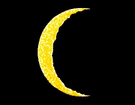The Islamic Calendar
The Islamic Calendar has 12 months but, unlike Western calendars, has only 354 days. This is because the Islamic Calendar (or Hijri Calendar) follows the movements of Earth's Moon. Like much of Islam, the calendar is based on the Quran and on personal reflection of the relationship between Muslims and Allah. Each month of the Islamic The 12 months of the Islamic Calendar, in order are these:
The Calendar is properly called the Hijri Calendar because it began with the Hijra, or hegira, Muhammad's flight from Mecca to Medina, which took place in 622 on the Western Calendar. The hegira took place, on Western Calendars, on July 16. Western, or Christian, Calendars measure time beginning with the year 0 A.D. On the Christian Calendar, A.D. stands for Anno Domini, which means "In the year of our Lord." The Hijri Calendar has years marked by A.H., which stands for Anno Hegirae, "In the Year of the Hijra." The hegira took place in A.H. 1. So, the year 2011 on the Christian Calendar is A.H. 1432 on the Hijri Calendar. (Remember that the Hijri Calendar is consistently 11 days shorter than the Christian Calendar.) The Hijri Calendar is the official calendar in many predominantly Muslim countries, most notably Saudi Arabia. In other countries, Muslims refer to the Christian Calendar for most dates and consult the Hijri Calendar only for religious purposes. The Hijri Calendar was introduced by Umar ibn Al-Khattab, a follower of Muhammad, in 638. |
|
Social Studies for Kids
copyright 2002–2024
David White



 Calendar officially begins when the lunar crescent is first seen after a new moon. This is not always an exact time, especially if the skies are cloudy or overcast. In a sense, the start of each month can be different for everyone. Many people, however, prefer to rely on an official announcement by Muslim authorities as to when each month begins.
Calendar officially begins when the lunar crescent is first seen after a new moon. This is not always an exact time, especially if the skies are cloudy or overcast. In a sense, the start of each month can be different for everyone. Many people, however, prefer to rely on an official announcement by Muslim authorities as to when each month begins. Islam has a few major holidays that Muslims celebrate throughout the year. Among them are these:
Islam has a few major holidays that Muslims celebrate throughout the year. Among them are these:
